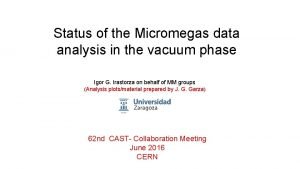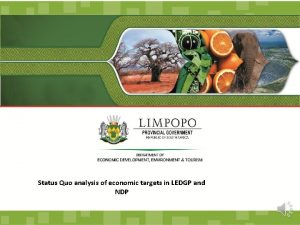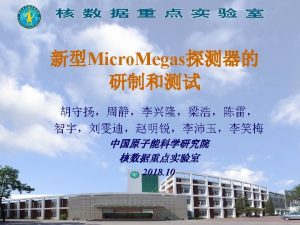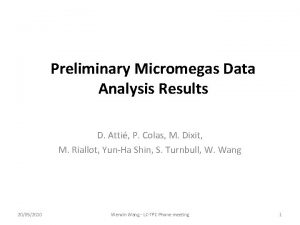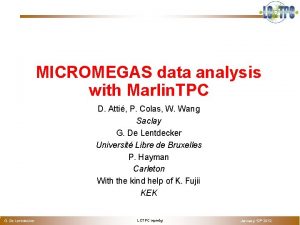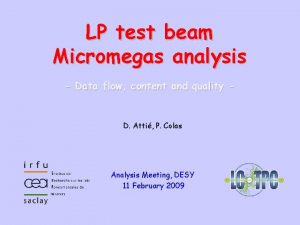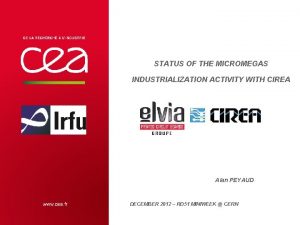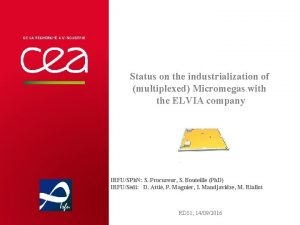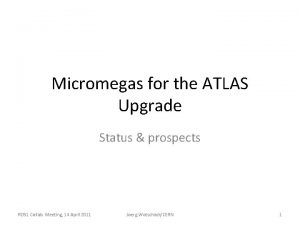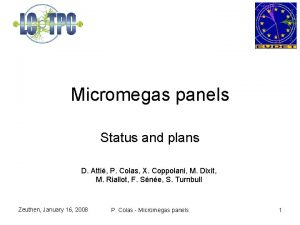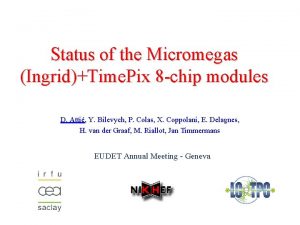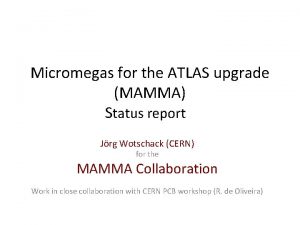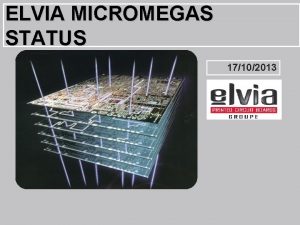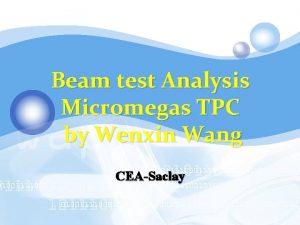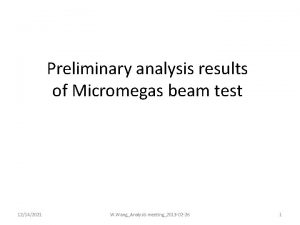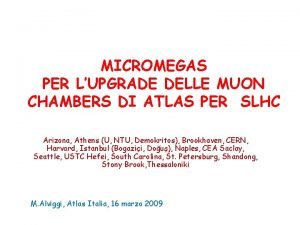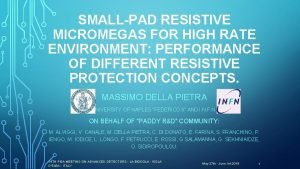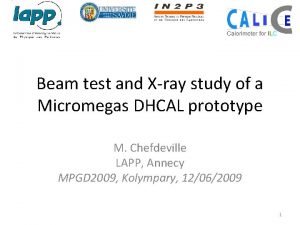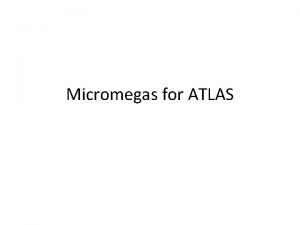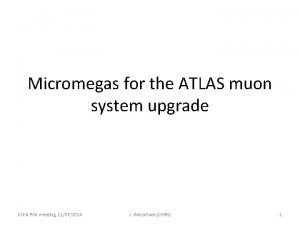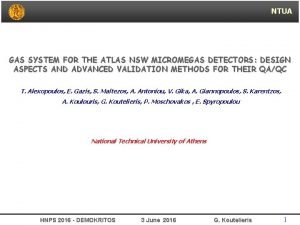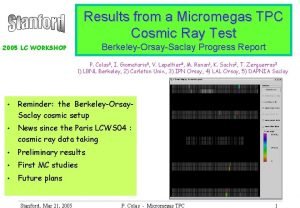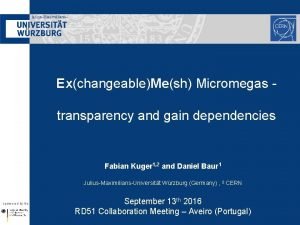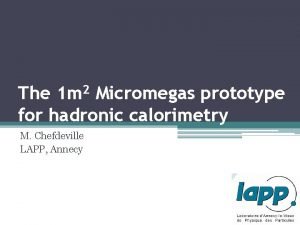Status of the Micromegas data analysis in the










![Sunset 2013 Year 2013 Detector Background Tracking [10 -6 c/ke. V/cm 2/s] Exposure [hours] Sunset 2013 Year 2013 Detector Background Tracking [10 -6 c/ke. V/cm 2/s] Exposure [hours]](https://slidetodoc.com/presentation_image/16f2477456304d05dedf9c4f4626dfcd/image-11.jpg)
![Sunset 2014 Year 2014 Detector Background Tracking [10 -6 c/ke. V/cm 2/s] Exposure [hours] Sunset 2014 Year 2014 Detector Background Tracking [10 -6 c/ke. V/cm 2/s] Exposure [hours]](https://slidetodoc.com/presentation_image/16f2477456304d05dedf9c4f4626dfcd/image-12.jpg)

![Sunset 22015 Year 2015 Detector Background Tracking [10 -6 c/ke. V/cm 2/s] Exposure [hours] Sunset 22015 Year 2015 Detector Background Tracking [10 -6 c/ke. V/cm 2/s] Exposure [hours]](https://slidetodoc.com/presentation_image/16f2477456304d05dedf9c4f4626dfcd/image-14.jpg)








![All data-sets combined [2 -7] ke. V Combined vacuum limit to gaγ would be: All data-sets combined [2 -7] ke. V Combined vacuum limit to gaγ would be:](https://slidetodoc.com/presentation_image/16f2477456304d05dedf9c4f4626dfcd/image-23.jpg)





- Slides: 28

Status of the Micromegas data analysis in the vacuum phase Igor G. Irastorza on behalf of MM groups (Analysis plots/material prepared by J. G. Garza) 62 nd CAST- Collaboration Meeting June 2016 CERN

Outline • Review of motivation from astrophysics (mainly stellar cooling anomalies) • Status of the data analysis. Background vs. Tracking levels. • Preliminary limit. • Remaining work • Longer term prospects 2

3

Astrophysical hints for axions/ALPs • Gama ray telescopes like MAGIC or HESS observe HE photons from very distant sources… ALP: 62 CAST CM, CERN, Sept-2016 Igor G. Irastorza / Universidad de Zaragoza 4

Plots from S. Troitsky 5

Astrophysical hints for axions (stellar cooling) • Most stellar systems seem to cool down faster than expected. Red Giants • Presence of axions/ALPs offer a good joint explanation (Giannotti et al. JCAP 05(2016)057 [ar. Xiv: 1512. 08108]) White dwarfs gag gae 62 CAST CM, CERN, Sept-2016 Neutron star CAS A Igor G. Irastorza / Universidad de Zaragoza 6

Material from M. Giannotti 7

New HB 95%CL limit 62 CAST CM, CERN, Sept-2016 Igor G. Irastorza / Universidad de Zaragoza 8 8

CAST MM vacuum data-sets (2013 -2015) Year 2013 2014 2015 62 CAST CM, CERN, Sept-2016 Detector Background Tracking [10 -6 c/ke. V/cm 2/s] Exposure gaγ @ 95% CL [hours] [10 -10 Ge. V-1] SS 1 0. 81 ± 0. 04 0. 79 ± 0. 18 92, 05 < 0. 96 SS 2 1. 48 ± 0. 06 1. 37 ± 0. 24 86, 46 < 1, 05 SS 1 1, 03 ± 0, 05 0, 94 ± 0, 17 117, 99 < 0, 88 SS 2 1, 05 ± 0, 05 0, 97 ± 0, 18 118, 05 < 0, 91 SR 1, 0 (0, 8) ± 0, 2 (0, 1) / 69, 8 SR 1, 20 ± 0, 07 3, 07 ± 1, 8 * 220, 4 SS 1 -P 1 0, 89 ± 0, 05 0, 77 ± 0, 18 79, 47 SS 1 -P 2 1, 65 ± 0, 09 1, 77 ± 0, 36 49, 74 SS 1 -P 3 1, 10 ± 0, 05 1, 32 ± 0, 25 83, 50 SS 2 -P 1 0, 89 ± 0, 05 0, 70 ± 0, 18 81, 34 SS 2 -P 2 1, 59 ± 0, 08 1, 04 ± 0, 27 51, 28 SS 2 -P 3 0, 90 ± 0, 05 0, 91 ± 0, 20 81, 98 Igor G. Irastorza / Universidad de Zaragoza < 0, 85 < 0, 92 < 0, 76 9 9

Sunset detectors 62 CAST CM, CERN, Sept-2016 Igor G. Irastorza / Universidad de Zaragoza 10
![Sunset 2013 Year 2013 Detector Background Tracking 10 6 cke Vcm 2s Exposure hours Sunset 2013 Year 2013 Detector Background Tracking [10 -6 c/ke. V/cm 2/s] Exposure [hours]](https://slidetodoc.com/presentation_image/16f2477456304d05dedf9c4f4626dfcd/image-11.jpg)
Sunset 2013 Year 2013 Detector Background Tracking [10 -6 c/ke. V/cm 2/s] Exposure [hours] gaγ @ 95% CL Backg. Track. [10 -10 Ge. V-1] SS 1 0. 81 ± 0. 04 0. 79 ± 0. 18 1700, 0 92, 05 < 0, 96 SS 2 1. 48 ± 0. 06 1. 37 ± 0. 24 1407, 8 86, 46 < 1. 05 Ø SS 1. Background: 363 events in 1700. 0 hours in 14. 53 cm 2. Tracking: Expected: 19. 5 events; Observed: 19 events. Ø SS 2: Background: 548 events in 1407. 8 hours in 14. 53 cm 2. Tracking: Expected: 33. 39 events; Observed: 31 events. 62 CAST CM, CERN, Sept-2016 Igor G. Irastorza / Universidad de Zaragoza 11
![Sunset 2014 Year 2014 Detector Background Tracking 10 6 cke Vcm 2s Exposure hours Sunset 2014 Year 2014 Detector Background Tracking [10 -6 c/ke. V/cm 2/s] Exposure [hours]](https://slidetodoc.com/presentation_image/16f2477456304d05dedf9c4f4626dfcd/image-12.jpg)
Sunset 2014 Year 2014 Detector Background Tracking [10 -6 c/ke. V/cm 2/s] Exposure [hours] gaγ @ 95% CL Backg. Track. [10 -10 Ge. V-1] SS 1 1, 03 ± 0, 05 0, 94 ± 0, 17 1854, 0 117, 99 < 0. 88 SS 2 1, 05 ± 0, 05 0, 97 ± 0, 18 1819, 6 118, 05 < 0. 91 Ø SS 1. Background: 501 events in [2 -7] ke. V in 1854. 04 hours in 14. 53 cm 2. Tracking: Expected: 31. 72 events; Observed: 29 events. Ø SS 2. . Background: 500 events in [2 -7] ke. V in 1819. 64 hours in 14. 53 cm 2. Tracking: Expected: 32. 23 events; Observed: 30 events. 62 CAST CM, CERN, Sept-2016 Igor G. Irastorza / Universidad de Zaragoza 12

Sunset 12015 Background Year Tracking gaγ @ 95% CL Detector [10 -6 c/ke. V/cm 2/s] 2015 Exposure[hours] Backg. Track. SS 1 -P 1 0, 89 ± 0, 05 0, 77 ± 0, 18 1237, 6 79, 47 SS 1 -P 2 1, 65 ± 0, 09 1, 77 ± 0, 36 783, 1 49, 74 SS 1 -P 3 1, 10 ± 0, 05 1, 32 ± 0, 25 1431, 5 83, 50 [10 -10 Ge. V-1] < 0, 92 Ø 3 data-sets with different background definition (the scintillator veto did not work for some time). Ø Period 1. 289 events in 1237. 6 hours Tracking: Expected: 18. 56 events; Observed: 16 events. Ø Period 2. 339 events in 783. 04 hours Tracking: Expected: 21. 46 events; Observed: 23 events. Ø Period 3. 412 events in 1431. 5 hours Tracking: Expected: 24. 02 events; Observed: 29 vents. 62 CAST CM, CERN, Sept-2016 Igor G. Irastorza / Universidad de Zaragoza 13
![Sunset 22015 Year 2015 Detector Background Tracking 10 6 cke Vcm 2s Exposure hours Sunset 22015 Year 2015 Detector Background Tracking [10 -6 c/ke. V/cm 2/s] Exposure [hours]](https://slidetodoc.com/presentation_image/16f2477456304d05dedf9c4f4626dfcd/image-14.jpg)
Sunset 22015 Year 2015 Detector Background Tracking [10 -6 c/ke. V/cm 2/s] Exposure [hours] Backg. Track. SS 2 -P 1 0, 89 ± 0, 05 0, 70 ± 0, 18 1236, 2 81, 34 SS 2 -P 2 1, 59 ± 0, 08 1, 04 ± 0, 27 800, 2 51, 28 SS 2 -P 3 0, 90 ± 0, 05 0, 91 ± 0, 20 1409, 2 81, 98 gaγ @ 95% CL [10 -10 Ge. V-1] < 0, 76 Ø 3 data-sets with different background definition (the scintillator veto did not work for some time). Ø Period 1. 297 events in 1263. 22 hours Tracking: Expected: 18. 93 events; Observed: 15 events. Ø Period 2. 334 events in 800. 17 hours Tracking: Expected: 21. 32 events; Observed: 14 events. Ø Period 3. 333 events in 1409. 2 hours Tracking: Expected: 19. 29 events; Observed: 20 events. 62 CAST CM, CERN, Sept-2016 Igor G. Irastorza / Universidad de Zaragoza 14

Sunrise System: MM+XRT (IAXO pathfinder) 62 CAST CM, CERN, Sept-2016 Igor G. Irastorza / Universidad de Zaragoza 15

Sunrise-2015 (MM + XRT) New Performance of Livermore XRT (efficiency + PSF) carefully measured in PANTER last July (see Jaime’s talk) Focusing properties anticipated with x-ray finger runs x-ray tracing simulations reproduce experimental data extremely well: Note this does not represent the “signal area” 62 CAST CM, CERN, Sept-2016 Igor G. Irastorza / Universidad de Zaragoza 16

Sunrise-2015 (MM + XRT) Livermore ray-tracing of XRT with expected “signal” input (solar axion incoming direction): Comparison of signal region & x-ray finger regions Rectangles are approximated regions enclosing different fraction of the signal: Area # Flux captured Area (cm 2) FOM 1 0, 727 0, 0312 4, 11 2 0, 888 0, 0580 3, 687 3 0, 967 0, 1008 3, 046 4 0, 996 0, 1872 2, 30 62 CAST CM, CERN, Sept-2016 Igor G. Irastorza / Universidad de Zaragoza Final analysis will not use these rectangles, but actual distribution above 17

Sunrise-2015 (MM + XRT) “calibration region”: region illuminated by 55 Fe source Pseudo-blind analysis: MM data analysis & signal region determination (ray-tracing) were done by independent teams (Zaragoza & Livermore) Background defined in the calibration region (A = 3. 14 cm 2); Bc = (1. 20 ± 0, 07)· 10 -6 c/ke. V/ cm 2/s Background & tracking counts Background defined in the Area # 4 (A = 0. 1872 cm 2); B 4 = (1. 51 ± 0. 33)· 10 -6 c/ke. V/ cm 2/s 3 signal counts found in the 95% enclosing rectangle for 0. 6 Area # Nexp from Bc Nexp from B 4 Tracking-counts 1 0, 148 ± 0, 009 0, 187 ± 0, 04 1 2 0, 276 ± 0, 016 0, 35 ± 0, 07 2 3 0, 479 ± 0, 028 0, 60 ± 0, 13 3 4 0, 89 ± 0, 05 1. 12 ± 0, 24 3 2015 numbers 62 CAST CM, CERN, Sept-2016 Igor G. Irastorza / Universidad de Zaragoza 18

Sunrise-2015 (MM + XRT) 62 CAST CM, CERN, Sept-2016 Igor G. Irastorza / Universidad de Zaragoza 19

Sunrise-2015 (MM + XRT) Efficiencies Expected signal 20

Sunrise-2014+2015 (MM + XRT) Background Year Detector 2014 SR 1, 0 ± 0, 2 2015 SR 1, 20 ± 0, 07 Tracking [10 -6 c/ke. V/cm 2/s] Exposure [hours] Backg. Track / 1379, 4 69, 8 3, 07 ± 1, 8 * 4125, 4 220, 4 gaγ @ 95% CL [10 -10 Ge. V-1] < 0, 85 * Defined with the 3 tracking counts. Ø 2014. 0 counts in spot in 2014. Ø 2015. Background: 281 events in 4125 hours in calibration-región (A = 3. 14 cm 2). Tracking: 3 counts in spot (Area #4, 18. 72 mm 2). Energies: 3. 05 ke. V, 2. 86 ke. V, 2. 56 ke. V. Ø Analysis in the range [1 -2] ke. V 0 tracking counts. 21

Sunrise-2014+2015 2014 + 2015 22
![All datasets combined 2 7 ke V Combined vacuum limit to gaγ would be All data-sets combined [2 -7] ke. V Combined vacuum limit to gaγ would be:](https://slidetodoc.com/presentation_image/16f2477456304d05dedf9c4f4626dfcd/image-23.jpg)
All data-sets combined [2 -7] ke. V Combined vacuum limit to gaγ would be: gaγ < 0. 628 · 10 -10 Ge. V-1 at 95% CL. (PRELIMINARY) ma = 35 me. V 23

Discussion on sunrise excess Statistical excess in SRMM 2016: 3 counts observed while 0. 6 ± 0. 1 expected (0. 8 if 2014 is added) • • • Energy of counts not compatible with Primakoff signal that’s why likelihood does not give significance to the signal hypothesis Sunset data does not show any excess Even without making any hypothesis on the signal shape, the excess is not sufficiently strong (~2 s) to prevent an “absence of signal” statement and derivation of upper limit. It may be just a background fluctuation after all… • Good to publish paper. BUT: • A tension remains (~2 s) with background-only hypothesis • Excess could be compatible with non-standard signal (axion-electron, out-of-resonance axion). • A “signal-around-the-corner” scenario cannot be excluded • The parameter space we are sensitive to is unexplored and motivated by astrophysics. • Enough motivation to plan an extended data taking to settle the question (washout the statistical excess if it is a background fluctuation) new proposal to CAST 24

Proposal for a new data taking run with sunrise MM system for discussion: • • How long? Goal to triple current SRMM exposure: 13 more months (minimal scenario: double current exposure 6. 5 months) Only sunrise (less burden on shifts) System is at CERN ready. Possible improvements from ongoing tests in IAXO-D 0 setup (none of this is essential, only in case they arrive on time): • AGET electronics • Better veto • Xenon instead of Argon How can this be accomodated with minimal effect on current experimental program? to discuss Motivation: • Physics: The parameter space we are sensitive to is unexplored and motivated by astrophysics. • Excess in current data: • Technological and political: keeping solar axion groups active and feed technologically IAXO 25

backup 26

IAXO-D 0 -Micromegas • Goal: demonstrate background levels below • First setup built at UNIZAR • Improvements over best CAST detector: • Better shielding and higher veto coverage • AGET electronics (autotrigger) better threshold • Xenon gas (remove fluorescences and Ar 39 radioactivity) 10 -7 c/ke. V/s/cm 2 at surface IAXO-D 0 MM setup at UNIZAR 27

Axion/ALP parameter space Transparency of the Universe Stellar cooling hints 28
 Micromegas analysis
Micromegas analysis Sources of content analysis
Sources of content analysis Define data collection method
Define data collection method Data preparation and basic data analysis
Data preparation and basic data analysis Data acquisition and data analysis
Data acquisition and data analysis Status quo analysis
Status quo analysis Status quo analysis
Status quo analysis Packet data convergence protocol
Packet data convergence protocol Hình ảnh bộ gõ cơ thể búng tay
Hình ảnh bộ gõ cơ thể búng tay Bổ thể
Bổ thể Tỉ lệ cơ thể trẻ em
Tỉ lệ cơ thể trẻ em Gấu đi như thế nào
Gấu đi như thế nào Tư thế worm breton
Tư thế worm breton Chúa sống lại
Chúa sống lại Các môn thể thao bắt đầu bằng tiếng chạy
Các môn thể thao bắt đầu bằng tiếng chạy Thế nào là hệ số cao nhất
Thế nào là hệ số cao nhất Các châu lục và đại dương trên thế giới
Các châu lục và đại dương trên thế giới Công thức tính thế năng
Công thức tính thế năng Trời xanh đây là của chúng ta thể thơ
Trời xanh đây là của chúng ta thể thơ Cách giải mật thư tọa độ
Cách giải mật thư tọa độ Làm thế nào để 102-1=99
Làm thế nào để 102-1=99 độ dài liên kết
độ dài liên kết Các châu lục và đại dương trên thế giới
Các châu lục và đại dương trên thế giới Thơ thất ngôn tứ tuyệt đường luật
Thơ thất ngôn tứ tuyệt đường luật Quá trình desamine hóa có thể tạo ra
Quá trình desamine hóa có thể tạo ra Một số thể thơ truyền thống
Một số thể thơ truyền thống Cái miệng bé xinh thế chỉ nói điều hay thôi
Cái miệng bé xinh thế chỉ nói điều hay thôi Vẽ hình chiếu vuông góc của vật thể sau
Vẽ hình chiếu vuông góc của vật thể sau
